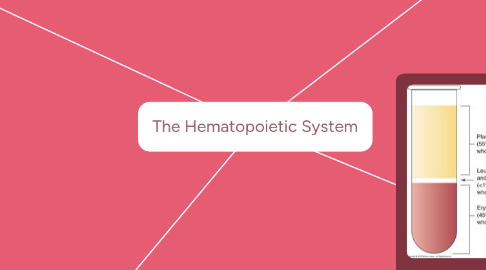
1. Anatomy Overview Part One
2. Anatomy Overview Part Two
3. 3. Blood Types
3.1. 4 Blood Types
3.1.1. Determined by the antigen on the cell membrane
3.1.1.1. A
3.1.1.2. B
3.1.1.3. AB
3.1.1.4. O
3.1.2. Universal donor: O type blood
3.1.2.1. Typo O blood does not have ANY antigen
3.1.3. Universal recipient: AB type blood
3.2. Rh Factor
3.2.1. Specific protein found on the cell membrane
3.2.1.1. Either positive or negative
3.2.2. Rh Positive can receive Rh negative OR positive blood
3.2.3. Rh negative can ONLY receive Rh negative
3.2.3.1. Receiving Rh positive blood can result in hemolysis or destruction of RBCs
4. Nursing Care of the Hematopoietic System
4.1. Assessment
4.1.1. Health history
4.1.1.1. Unexplained blood loss, rectal bleeding, nosebleeds, bleeding gums or vomiting blood
4.1.1.2. Fatigue
4.1.1.3. Dizziness or fainting
4.1.1.4. Bruising
4.1.1.5. Frequent infections
4.1.1.6. Difficulty swallowing with throat tenderness
4.1.1.7. History of lymph node removal, splenectomy, cancer treatment, or renal failure
4.1.2. Medications
4.1.2.1. Antibiotic use
4.1.2.2. Chemotherapy
4.1.2.3. Aspirin and anticoagulants
4.1.3. Foreign travel
4.1.3.1. Malaria or parasitic roundworm
4.1.4. Dietary
4.1.4.1. Adequate intake of iron, B vitamins, protein, folic acid, vitamin C, vitamin E
4.1.4.1.1. See Nutrition Notes on Page 504 of Timby Medical Surgical
4.1.5. Physical Assessment
4.1.5.1. Palpate lymph nodes
4.1.5.2. Inspect skin for color abnormalities
4.1.5.2.1. Ecchymosis
4.2. Diagnostics
4.2.1. Blood tests
4.2.1.1. Complete Blood Count
4.2.1.2. Clotting tests
4.2.1.2.1. Prothrombin time
4.2.1.2.2. Fibrinogen level
4.2.1.2.3. Activated partial thromboplastin time
4.2.1.2.4. D-Dimer
4.2.2. Bone Marrow Aspiration
4.2.2.1. Identifies types and percentage of immature and maturing blood cells
4.2.3. Schilling Test
4.2.3.1. Determines etiology of vitamin B12 deficiency
4.2.3.1.1. Dietary deficiency of Vitamin B12
4.2.3.1.2. Deficiency of intrinsic factor
4.2.3.1.3. Malabsorption of Vitamin B12
4.2.3.1.4. Deficiency of protease
5. 2. Blood Components
5.1. Platelets (Thrombocytes)
5.1.1. Major function is to participate in clotting of blood
5.1.2. Manufactured in the red bone marrow
5.1.3. Hemostasis - control of bleeding
5.1.3.1. 1/3 of platelets are stored in the spleen for emergency clotting
5.1.3.2. 2/3 of platelets circulate in the blood for hemostasis
5.1.4. Normal lab value
5.1.4.1. 150,000 to 350,000/mm3
5.1.5. Lifespan: 7.5 days
5.2. Leukocytes (WBCs)
5.2.1. Normal Range: 5,000 to 10,000
5.2.2. Leukocytosis - Increased number of WBCs
5.2.3. Leukopenia - Decreased number of WBCs
5.3. Plasma & Plasma Proteins
5.3.1. Plasma: liquid (serum) portion of the blood
5.3.1.1. Major function is to circulate blood cells
5.3.1.1.1. 10% proteins
5.3.1.1.2. 90 % water
5.3.2. Proteins
5.3.2.1. Albumin
5.3.2.1.1. Helps maintain the osmotic pressure that retains fluid in the vascular compartment
5.3.2.2. Immunoglobulins
5.3.2.3. Fibrinogen
5.3.2.3.1. Key role in forming blood clots
5.4. Erythrocytes (RBCs)
5.4.1. Major function is to transport O2 and remove CO2 from the tissues
5.4.2. Erythropoiesis
5.4.2.1. The production of RBCs
5.4.2.1.1. Controlled by erythropoietin
5.4.2.1.2. Nutrients required for maturation
5.4.3. Normal number of erythrocytes
5.4.3.1. Varies with age, gender, and altitude
5.4.3.1.1. Infants have more RBCs
5.4.3.1.2. Women have less RBCs than men
5.4.3.1.3. Higher altitude = more RBCs
5.4.3.2. Normal range: 3.6 to 5.4 million/mm3
5.4.4. Hemoglobin
5.4.4.1. iron-containing pigment attached to erythrocytes
5.4.4.1.1. binds with O2 to carry through the blood
5.4.4.2. Normal range: 12.0 to 17.4 g/dL
5.4.5. Lifespan: 120 days
5.4.5.1. Spleen and liver remove old RBCs
5.4.5.2. Iron is "recycled"
5.4.6. Gerontologic considerations
5.4.6.1. Decreased renal perfusion can lead to decreased RBC production
5.4.6.2. Overall decrease in cell flexibility and number
6. 1. Bone Marrow
6.1. Soft tissue that fills the spaces of interior long bones and spongy bones
6.2. Manufactures blood cells
6.3. Two types of bone marrow
6.3.1. Yellow marrow
6.3.1.1. Found in fat cells and connective tissue
6.3.1.2. Does not manufacture blood cells unless under intense stimulation conditions
6.3.2. Red marrow
6.3.2.1. Found in the ribs, sternum, skull, clavicles, vertebrae, iliac crest, and end of long bones
6.3.2.2. Function: Manufactures blood cells and hemoglobin
